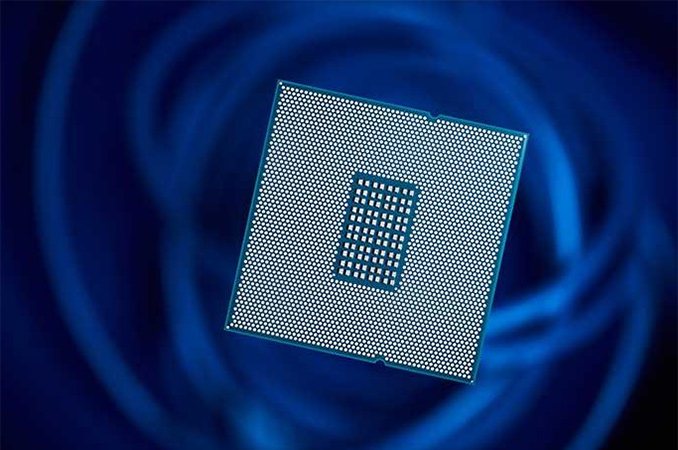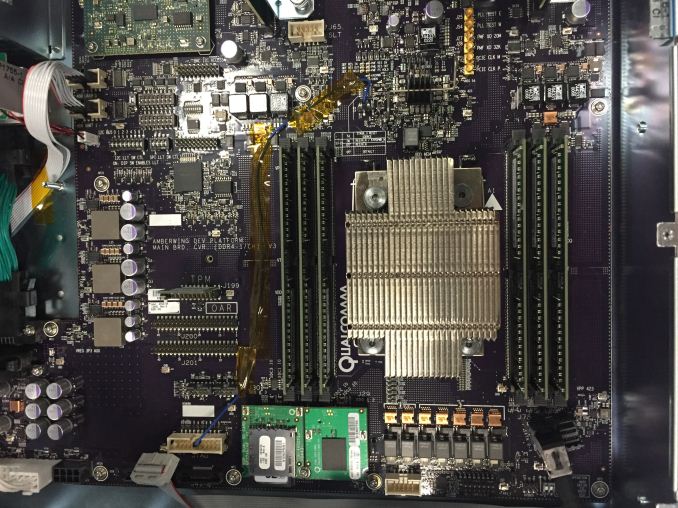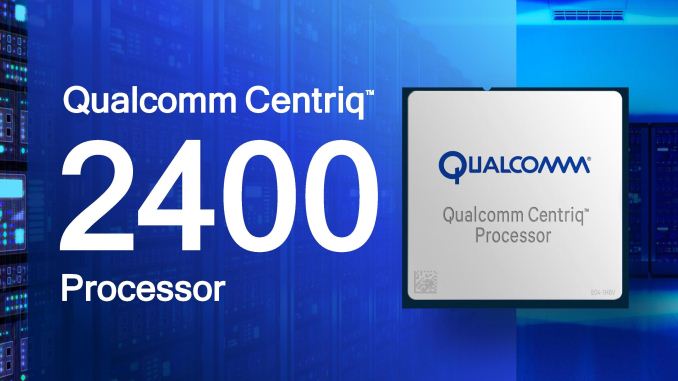Qualcomm’s Server Team Loses VP of Technology, Centriq Future Unknown
by Ian Cutress on July 6, 2018 2:00 PM EST- Posted in
- CPUs
- Qualcomm
- SoCs
- Enterprise CPUs
- Servers
- Centriq
- Centriq 2400

Normally we don’t particularly comment on these sorts of transitions at big companies unless they are C-level (CEO, CTO), however the narrative surrounding Qualcomm’s Centriq product line is still one that is perceived to be in flux. Qualcomm never commented on the rumors about its plans to find a buyer for Centriq, despite Axios and Bloomberg both reporting on them, and as a result never confirmed or denied the proposition: ultimately leading others to speculate. Followed by Anand Chandrasekher’s swift exit, again without public comment about reasons or replacement, and now another senior figure exiting the scene, brings more questions to the table than it answers.
The team behind Qualcomm Datacenter Technologies server platform, Qualcomm’s Centriq, has been in the news this past year as one of the key players in bring Arm architecture cores to the server and enterprise market. So far the time line looks like this:
- November 2014: Announced Plans to Enter Server Market
- December 2016: First 48-Core Demo and Sampling
- August 2017: Falkor Microarchitecture Detailed (Hot Chips)
- November 8th 2017: Cloudflare publishes integration testing
- November 10th 2017: Official Launch (for revenue) and Pricing
- May 8th 2018: Bloomberg Reports QDT may abandon Centriq
- May 13th 2018: Anand Chandrasekher, President of QDT, Leaves
- June 14th 2018: QDT Downsizing, 280 Jobs Cut
In 2017, Qualcomm announced the Centriq 2400 family of processors, built on Arm architecture cores at 10nm, for the enterprise and server market. This was meant to be the big break for Arm cores in the server market by a massive player that has the engineering staff and infrastructure to build a sizable customer base. The biggest version of the design implemented 48 of Qualcomm’s Falkor Arm v8 cores, paired with 60 MB of L3 cache, six channels of DDR4, running at a 2.2 GHz base frequency for 120W TDP and a price just shy of $2000: it was set to compete aggressively in the cloud server markets in performance per watt, overall performance, and cost. To date, Cloudflare has made the biggest noise about transitioning its DDoS protection platform from x86 to Centriq.

Qualcomm Centriq 'Amberwing' Development Platform, from Cloudflare
| Qualcomm Centriq 2400 Series | |||
| AnandTech.com | Centriq 2460 | Centriq 2452 | Centriq 2434 |
| Cores | 48 | 46 | 40 |
| Base Frequency | 2.2 GHz | 2.2 GHz | 2.3 GHz |
| Turbo Frequency | 2.6 GHz | 2.6 GHz | 2.5 GHz |
| L3 Cache | 60.0 MB | 57.5 MB | 50 MB |
| DDR4 | 6-Channel, DDR4-2667 | ||
| PCIe | 32 PCIe 3.0 | ||
| TDP | 120 W | 120 W | 110 W |
| Price | $1995 | $1373 | $888 |
However since the announcement, availability from the major server providers has been next to nil.
Back in May this year, almost at the same time as reports suggesting that Qualcomm was looking to offload (sell/close) the server processor division, Anand Chandrasekher left the company without much of a warning, at least publically, and aside from a personal tweet about leaving Qualcomm, no official note was given as to Anand’s replacement. The reports regarding the company offloading the server division were never confirmed, and behind the scenes several trusted sources reached out to AnandTech to say that this wasn’t really the case. Qualcomm has kept mum on the issue.
Fast forward to today, and another surprise hit our screens. One of the key members of the Falkor team, Dr. Dileep Bhandarkar, VP of Technology at Qualcomm Datacenter Technologies (QDT), seems to have parted from the company. Dileep was very much a key person for Falkor, purposefully spending time to track us down at Hot Chips after we published our detailed microarchitecture analysis and introduce us to the engineers, as well as chairing the Server Processor round of talks at the same event. The reasons for Dileep’s transition out of QDT are unknown. His departure was discovered due to his speaker biography for SemiCon West 2018 stating ‘formerly Qualcomm’.
Dr. Bhandarkar’s role is an important one here: he was a Director of Advanced Architecture at Intel for 12 years until 2007 (being a lead spokesperson for Intel’s server platform technologies), is an IEEE Life Fellow, has spent almost six years at Microsoft driving innovation and standards for its datacenters, and then a similar amount of time at Qualcomm working on technology strategy and business development, developing (among other things) machine learning accelerators currently in use at a major cloud provider. It would appear that rather than joining another industry behemoth, he is starting his own DNN based business.
So normally we don’t particularly comment on these sorts of transitions at big companies unless they are C-level (CEO, CTO), however the narrative surrounding Qualcomm’s Centriq product line is still one that is perceived to be in flux. Qualcomm never commented on the rumors about its plans for Centriq, despite Axios and Bloomberg both reporting on them, and as a result neither confirmed nor denied the proposition officially, ultimately leading others to speculate. Followed by Anand Chandrasekher’s swift exit, again without public comment about reasons or replacement, and now another senior figure exiting the scene, brings more questions to the table than it answers.
Whatever Qualcomm’s plans for Centriq have been, they seem to have stalled. It would appear that the product still does not seem to be available on the open market from the standard server manufacturers, and despite lots of talk citing the products wins over Xeon chips, nothing new has been said for quite a while. These OEMs are instead pushing Cavium’s ThunderX2 designs, which seem to have been gaining traction. Despite discussing with the Centriq team about being sampled for review in Q4 last year, that never materialized. Bloomberg also reported (via notices filed at a state level) a few weeks back that the company was cutting its datacenter unit in half, with up to 280 jobs on the line. It is possible that Dr. Bhandarkar's departure may have been one of these. The same report states that Qualcomm will continue its joint ventures in China, and rather than closing the unit will ‘persevere with a revised strategy’.
“Qualcomm remains committed to data-center opportunities and is not divesting the assets,” Amon said to Bloomberg. “We are reducing our investments in the data-center business but remain committed to our China JV and to refocusing our R&D efforts for upcoming compute opportunities.”
Source: SemiCon West













34 Comments
View All Comments
MrSpadge - Friday, July 6, 2018 - link
Seems like they're giving up the future ARM server market before really trying to create it - yet spent most of the R&D for it. Is the product really this bad?Yojimbo - Saturday, July 7, 2018 - link
It's much cheaper to research a project than it is to actually try to bring it to market in volume. The product doesn't have to be really bad in order to stop short of pursuing it. It just has to be deemed to be financially undesirable. If they really want to sell the chip they will have to commit to years of support, that could place a drag on their margins for years to come.Reflex - Saturday, July 7, 2018 - link
The product could be great, it wouldn't matter. There simply isn't a good reason to replace x68 in the server space at this time. There are low price options coming from both Intel and AMD, the power efficiency of both puts them in the budget of a typical datacenter, and the software stack is mature and performant.ARM in servers is having the same problem Intel has had getting x86 in phones.
Yojimbo - Sunday, July 8, 2018 - link
"The product could be great, it wouldn't matter. There simply isn't a good reason to replace x68 in the server space at this time."Then why is ThunderX2 seeing traction?
Reflex - Monday, July 9, 2018 - link
It's been out for more than two years now and I'm not aware of it even hitting 1% of the server market, even if you try to choose a specific niche. I'm not certain what your definition of 'seeing traction' is, but I'd expect to see it show up in market share charts which to date it does not seem to have. If it has somewhere, please let me know as I'm honestly curious.I've also noticed that most of the news around Cavium's server products has gone dark since the Marvell acquisition, I'm honestly not certain they are focused on that market or considered it a major part of the assets when they acquired it.
Yojimbo - Monday, July 9, 2018 - link
"It's been out for more than two years now"No it hasn't. It's been out since May of this year: https://www.cavium.com/news/cavium-announces-thund...
Seeing traction:
https://www.top500.org/news/sandia-to-install-firs...
https://www.hpcwire.com/off-the-wire/bright-comput...
https://www.zdnet.com/article/caviums-thunderx2-pr...
https://www.servethehome.com/cavium-thunderx2-gain...
http://gw4.ac.uk/isambard/
Yojimbo - Monday, July 9, 2018 - link
Sorry, I put a period in front of the first link. https://www.cavium.com/news/cavium-announces-thund...Reflex - Monday, July 9, 2018 - link
Sorry, I was looking at the first gen. For the second gen, I'm still not seeing traction in terms of marketshare. The links provided are PR announcements, not marketshare metrics and may or may not get actually built (lots of stuff like that gets announced then never gets funded). Also, the number of actual servers being built appears to be quite small per those links, a 4096 CPU cluster is not all that impressive when its a 48 core chip..Again, not saying its dead or anything, but this is a long way from what I'd consider to be significant traction. It looks exploratory more than anything else.
Yojimbo - Monday, July 9, 2018 - link
Well it was just fully released in May. You won't see market share, yet. You also won't see much for a while. The articles I posted aren't just PR they show two things about ThunderX2 that can't be said for Centriq. Firstly, that it is being put into HPC machines. Of course, Centriq isn't really HPC capable, but the point is that being put into actual machines, especially the 2.3 petaflops machine, is significant. Secondly, server makers are actually developing products based on ThunderX2. I only posted that one workstation but I remember seeing a server announced. I don't recall seeing anything like that for Centriq.I'm not sure what your definition of traction is. You seem to be looking for being on the road. Traction, to me, just means that it's not just spinning its wheels, which is what ARM server chips have been doing for the past 10 years. Note that in 2008 GPUs had very little real revenue for compute acceleration, yet it was clear that it was something being taken seriously.
As far as those HPC projects, they are already funded, they are being built. Sometimes they get canceled because of technology/component cost shortfalls and disagreements about how to deal with them. But it's not like weapons system development. You can be pretty sure they will be built. The 2.3 petaflops system will be delivered soon, in fact. According to the article it will be installed later this year. 2.3 petaflops would put it in the top 100 systems in the world in the latest (June) Top 500 list, btw.
Reflex - Monday, July 9, 2018 - link
I'm not sure how you are defining traction. Qualcomm actually had some reasonably large scale real world deployments (most prominently CloudFlare). I don't see anything like that, and today's article does not emphasize servers at all. If its too soon to say that my expectations are 'down the road' then its too soon to say that its gaining traction. At this point the deployments don't actually exist, its just announcements. Even if they did, they are such a minuscule part of the markets they are in that they can best be described as experiments.It's pretty fair to say its too soon to call.